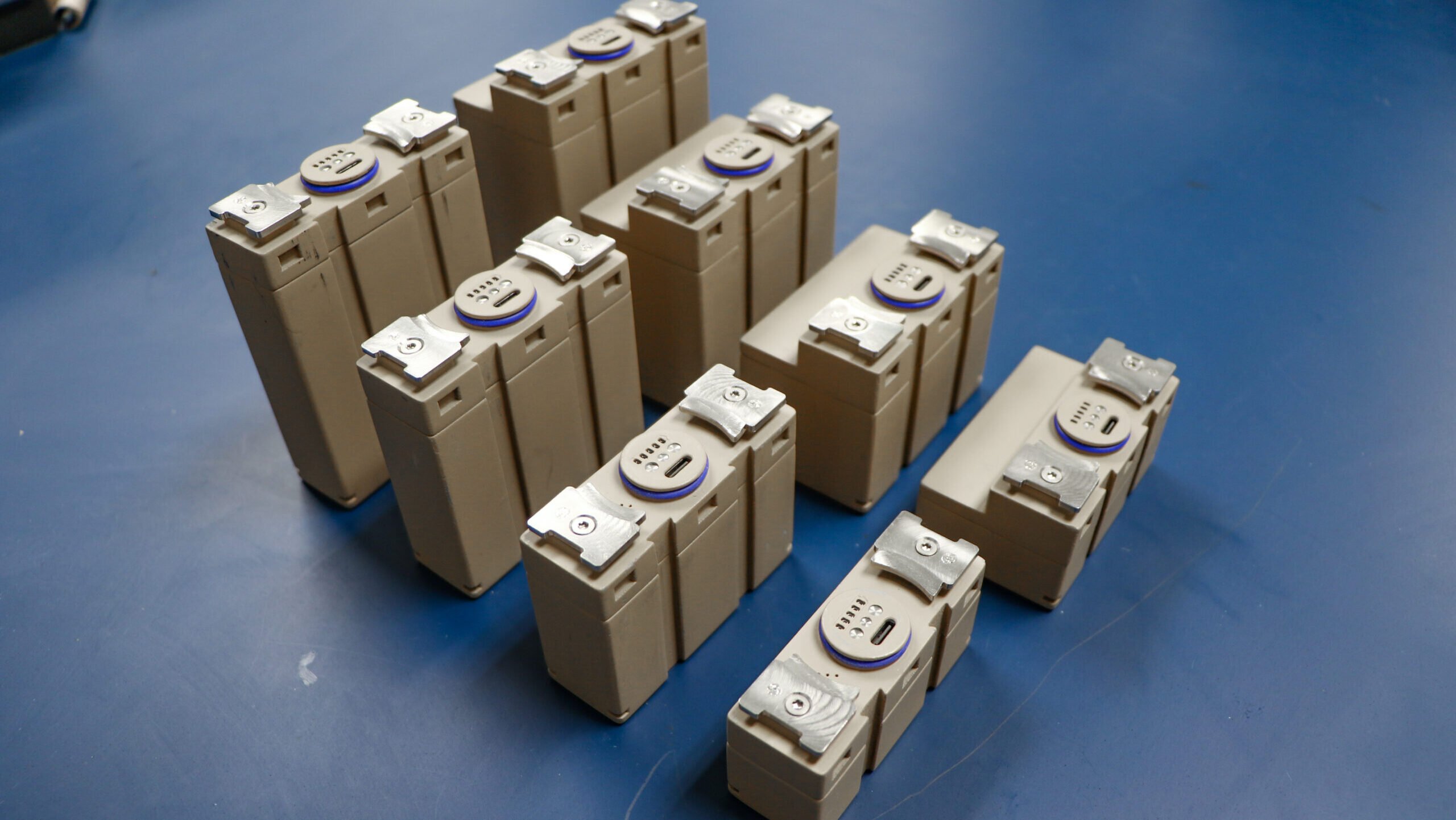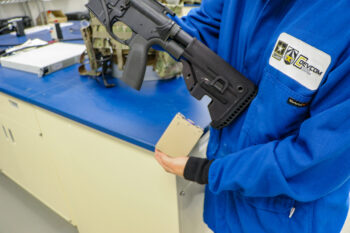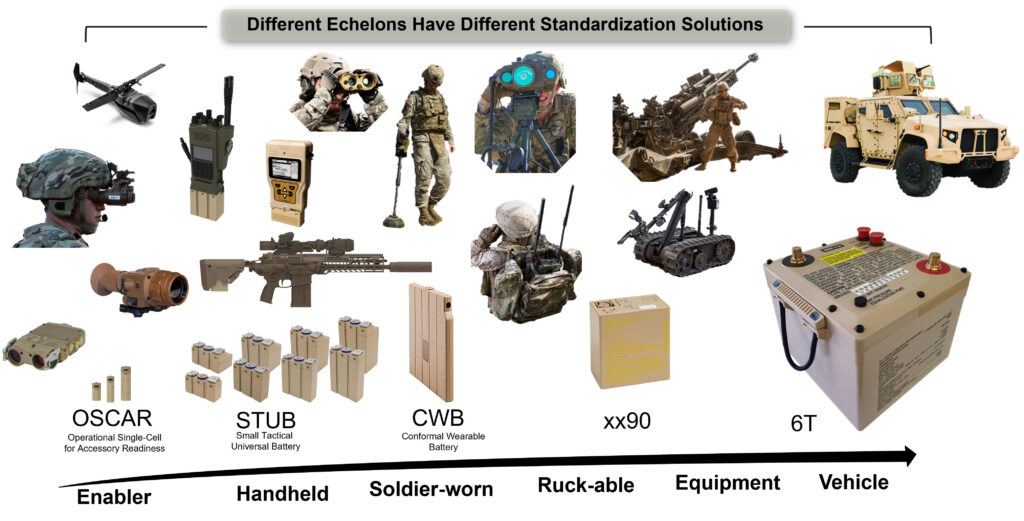
The new STUB (Small Tactical Universal Battery) comes in eight sizes, each with a different capacity but all interchangeable in the same power slot. (Army photo by Daniel Lafontaine)
WASHINGTON — Festooned with radios, rifle scopes, night vision goggles and GPS, US soldiers typically carry 15 to 20 pounds of batteries for a 72-hour mission, with some specialists hauling nearly 30. (Marines face similar issues). After then-Army Chief of Staff Mark Milley launched a sweeping modernization program in 2017, it quickly became evident that troops would need even more power for all sorts of new tech, from digital radios to mini-drones, advanced gunsights and even — if the Army can get them to work — VR targeting goggles.
To make things worse, devices from different manufacturers tend to use different types of batteries. That’s a headache for supply officers and a nightmare for troops in combat: Imagine the annoyance of rummaging through your kitchen drawer to find the right battery for some crucial appliance, multiplied by being exhausted, in the mud and under enemy fire. “Soldier Touchpoints,” where ordinary troops tried out prototype tech, made clear that the proliferation of incompatible batteries was a potential problem.
“There’re a lot of really good capabilities that were suggested then that are coming out now,” said Nathan Sharpes, a research engineer at the Tactical Power team in the service’s C5ISR Center, said an interview with Breaking Defense. “But … if we kept on the status quo … each one of those new capabilities would probably get a proprietary battery.”

A prototype STUB battery about to be slotted into a weapon-like test rig. (Army photo by Daniel Lafontaine)
So the Tactical Power team started looking for ways to lighten and simplify soldiers’ battery burden. The first product of that project, called STUB (Small Tactical Universal Battery), is now in qualification trials. Research is now ramping up on an AA-sized rechargeable battery the lab calls OSCAR (Operational Single Cell for Accessory Readiness).
It’s not practical to have every single item a soldier carries run off the exact same battery, Sharpes said. That’s why Tactical Power is pursuing both STUB and the smaller OSCAR. STUB, in turn, has eight sizes that fit into the same slot and plug in the same way, making them interchangeable.
“Any STUB would work with any device designed for STUB, it would just be a matter of how much run time you would get,” Sharpes said. “More energy is more size. That’s why there’s eight different size of STUB.”
STUB needs to be available in multiple sizes because it aims to replace a wide array of batteries for handheld and “small form factor” devices, from small GPS locators to night vision goggles to tactical radios. That “is probably the most diverse array” in terms of power demands, Sharpes said. “That was really the echelon of devices that needed the most help,” Sharpes said, “[so] we chose to prioritize the STUB.”
By contrast, the OSCAR, which is “very much still in development,” will go on smaller devices, like rifle-mounted thermal scopes or rangefinding lasers, and it will largely replace the widely used AA. But why bother inventing something new when there’s already a de facto commercial standard? Because Army soldiers have different and more demanding needs than civilians powering a flashlight or clock radio, Sharpes and his team argued.

The STUB, now in testing, and the smaller OSCAR, in development, will fit into a larger array of Army batteries. (Army graphic)
“We do tend to pursue newer chemistries, because our requirements are so high that typically the commercial-off-the-shelf stuff can’t meet them,” Sharpes said.
In particular, rechargeable batteries for civilian users tend to be optimized to survive hundreds of charge-discharge-recharge cycles without dying: “For your electric vehicle or your iPhone, you’d be upset if it only lasted for a year,” Sharpe said. But frontline use is so hard on gear that it’s better to optimize for raw capacity per charge, even if the battery burns itself out in a matter of months, because it will probably get broken by then anyway.
The Tactical Power team is also researching batteries that don’t die in extreme weather conditions, like the technology-killing 50-below-zero temperatures experienced by the Army’s year-old “Arctic Angels” division. If successful, cold-resistance and other potential improvements should be relatively easy to add to STUB and OSCAR, the team said, because manufacturers just have to put the improved internal chemistry into the same package, so the upgraded batteries will be interchangeable with the originals.
Sharpes made clear that STUB and OSCAR won’t be mandatory for Army equipment. Instead, he said, they’ll be offered as options to any program manager developing new gear. The team is already working with several program managers, he said. The idea is that an Army-certified, field-tested and above all standardized battery will be more appealing than bespoke batteries — but if a particular piece of kit really needs a unique, non-standard power solution, it will still be allowed to develop one.
So STUB and OSCAR will have to earn their way into new gear, Sharpes said. “If it’s a good idea, then it’ll proliferate naturally, and if it’s not, then it shouldn’t.
France, Germany ink deal on way ahead for ‘completely new’ future European tank
Defense ministers from both countries hailed progress on industrial workshare for a project that they say “will be a real technological breakthrough in ground combat systems.”


























